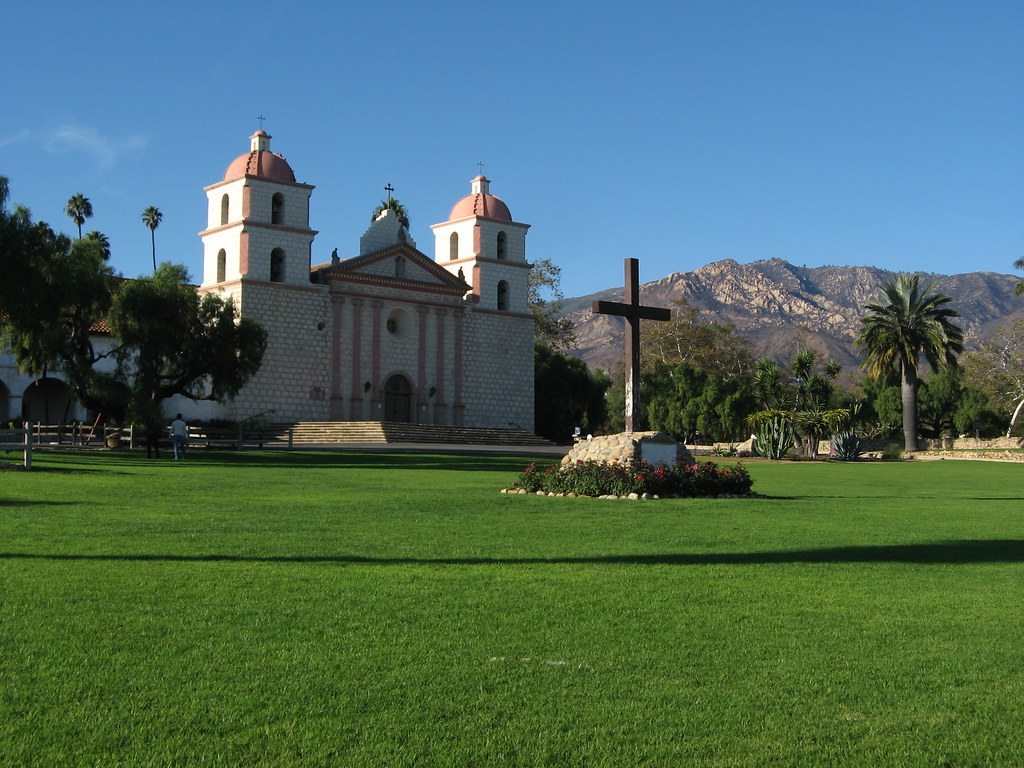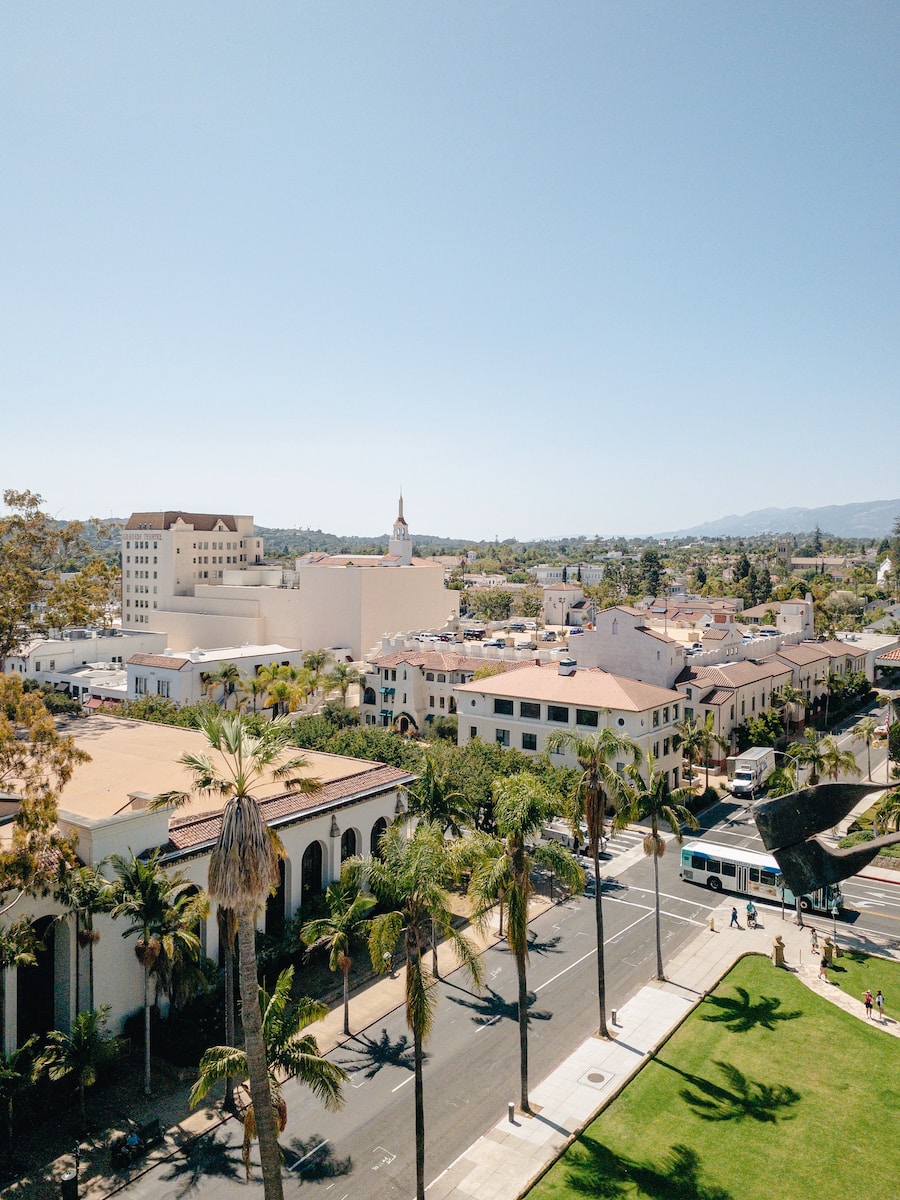
Mission Santa Barbara was founded by Father Serra in 1786 and is located on a rise above the harbor of Santa Barbara. The mission was named after Saint Barbara, the patron saint of artillerymen and miners. Mission Santa Barbara is often referred to as “The Queen of the California Missions” because of its unique architectural style which combines elements of both Spanish and Moorish design.
Its symmetry and stunning construction make it a sight to behold, and its location – perched atop a hill with sweeping views of the ocean – make it even more special. A visit to this mission is a must-do when exploring California’s history.
The site chosen for the Santa Barbara mission by Junípero Serra was close to the sea and central to both the northern and southern missions. By being centrally located, the mission was easily accessible to all people in the area, which made it ideal for Serra’s goals of conversion and evangelization. Unlike other missions in California, the Franciscans have maintained control of Mission Santa Bárbara continuously since it was founded, while most of the other missions have had to be re-established at some point.
The Chumash Native Americans were the original inhabitants of the area. They were a peaceful people who lived off the land, fishing and gathering crops. They had a rich culture and were renowned skilled artisans, creating beautiful baskets and jewelry. They were also master wood, pipes, figurine and bowl carvers. They wove intricate designs into their crafts made of beads, bone and shells. Sadly, the Chumash were decimated by disease when the Spanish arrived in their homeland, and their population never recovered.
Getting There
Located just a few minutes off the 101 Freeway, there are signs posted along way directing visitors to the mission, and you can also find directions by putting the mission’s address into Google Maps. The parking lot is large enough that you should be able to find a spot without any trouble. There’s plenty of room, so you shouldn’t have to worry about not being able to park.
The Mission Exterior
The exterior of Mission Santa Barbara is adorned with a beautiful garden and is filled with an array of vibrant flowers and plants that create a stunning landscape. The façade of the mission is decorated with two rows of arches that are supported by double columns. Above the arches, there is a parapet that is adorned with tile work.
When you are outside, take a moment to appreciate the old stone lion carving done by a Chumash Indian. The carving is located on the historic cistern, which makes it even more special. In addition, the fountain here is just as beautiful as some of the fountains at San Juan Capistrano.
The Sacred Garden
The garden is a large courtyard and garden in the complex. It was initially used as a work area when the mission was thriving, but now it is just a large courtyard and garden. The courtyard was once full of life, with people working and children playing. Now, it is a place where people come to relax and enjoy the beauty of the garden. The pathway is designed so that you can admire the views as you walk up to it, but the entryway itself is closed off.
The Cemetery
The cemetery is the main and preeminent outside area for this mission. This is where we come to bury our dead, and to honor and remember them. It is a place of peace and solitude, and a place where we can reflect on the lives of those who have passed on. The large walkway leads you around a bay fig tree that has been there for two centuries.
The exterior of the mission is home to many different mausoleums and grave sites, each paying tribute to a different person of importance in the mission’s history. There is also a large cross right in the middle that is another highlight in the area.
The Chapel
There is no doubt that the chapel for Mission Santa Barbara is stunning. The whitewashed adobe walls and red tile roof complement the mission’s natural surroundings perfectly. Inside, the chapel is decorated with beautiful Spanish Colonial paintings and sculptures. Visitors can’t help but be impressed by the overall beauty of this mission.
The altar piece consists of a large central panel with smaller side panels. The central panel is usually brightly colored and decorated with scenes from the Bible or saints. The side panels are often more embellished, with intricate carvings and gold leaf.
Once done enjoying the peaceful chapel, you will head your way out of the back door and on to the museum. The museum holds many artifacts and paintings from throughout history that are sure to intrigue you.
The chapel also has an area that shows how it has been destroyed and rebuilt over the years. We found this information to be interesting and helps give context to the chapel’s current state.
The Museum
There are roughly six rooms in the museum that are set up like the other missions, with displays and exhibits dedicated to educating visitors about the history and culture of the area. These rooms are typically larger than the others and contain more artifacts, as well as artwork and interactive elements.
The rooms were originally built to house the missionaries and their guests. On this day, they showcase a variety of art pieces as well as recreations of the original rooms’ appearance. This is a great opportunity to see how people lived long ago and to also see some amazing works of art.
Situated in an ideal location that offers breathtaking views surrounded by beautiful gardens, Mission Santa Barbara is not just exceptionally beautiful but a great mission to visit if you’re interested in learning about the state’s history as well.
Needless to say, it is a great mission to visit if you’re interested in learning about the state’s history. It’s also one of the best-preserved missions, making it a great place to learn about early Californian life. Visitors can easily spend a leisurely day exploring all that the mission has to offer.


0 Comments